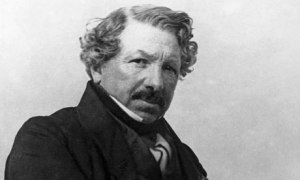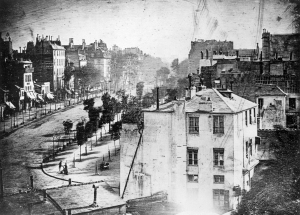I lift my head toward the light for this …
July 10th marks the 164th anniversary of the death of one of the founders of photography, Louis-Jacques-Mandé Daguerre. Daguerre was a French painter and well-known set designer for the Paris stage. He was not a photographer, but only because the media had yet to exist at that time.
Daguerre invented the type of photographic image that would bear his name: Daguerreotype. The process consists of mirror-polishing a sheet of silver-plated copper, making it light-sensitive through exposure to iodine fumes, exposing the light-sensitive plate in-camera for a to-be-guessed time, then developing the latent image in a fuming box filled with dangerous mercury vapor. This was just to get an image, not to keep it from disappearing or from being erased with the touch of a fingertip.
Boulevard du Temple, Paris, 8 in the morning
( Louis-Jacques-Mandé Daguerre)
Don’t underestimate the significance of this image. It may seem common-place today. Historically, it is one of the most significant photographic images of all time. Look in the lower left portion of the image. It is believed to be the very first photograph of humans, ever.
The three things we don’t know about the image:
1. The year created. We believe it was either 1838 or 1839.
2. The exposure. Estimates range from several minutes to fifteen.
3. If Daguerre staged the image, or at least framed it with the first photographic humans intentionally staged.
Daguerre was well-versed in the art of staging, and importance of scene placement and framing. That said, he was making up the dark chamber painting-with-light thing as he went. Does that mean that, in the lower left of the image, Daguerre deliberately framed the shoe shiner and his customer?
Did he know that they would be the only two people in focus, and serve as an anchor for the image? Did he get that the rest of the Parisians on the busy street would be invisible blurs, because they moved throughout the exposure? Or was he simply interested in any image at all, and captured the shoe shining evolution merely by chance?
The three things we know about the image:
1. It was created at 8 am on a Paris morning. We may not know the year, but we know the time, because Daguerre chose to include it in his image title. Somehow to me, the time is more significant to the image than the year.
2. The original plate size was 6.5 inches by 8.5 inches. That was the plate size of Daguerre’s camera. We call it full-plate size, because it’s about the largest plate that a normally sized person can manipulate in one hand, while doing everything else necessary to make the image.
3. Photography is magic. It’s alchemy, or at least it was. If it is too commonplace today, it is only because of the amazing historic advancements of optics experts, chemists, engineers, painters and other non-photographic artists whose obsessions over-shadowed fears.
Our fathers of the photographic process are the reason we take the photographic image for granted today. They are to blame for bringing the media to, “the common man”. It’s, “just a photograph,” for so many of us and our viewers. And we are to blame, with all the tools and resources at our literal touch, for those times photography is common, a sub-genre to fine art. We are the reason that it has not come full-circle, to be viewed again as alchemy, as magic, or at least as magical.
Daguerre created a total of three daguerreotypes of the Parisian street scene below his open window. They survived the bombings of World War II, only for all three to be destroyed during a restoration attempt in 1974. They exist today only in reproductions. Ironically, the process that surpassed the daguerreotype in popularity had been used to photograph Daguerre’s original plates. The reproductive prints were used to create the Daguerre reproductions we’ve got to today.
I think the last time I assigned the word, “obsessed,” to someone, it was to Thomas Edison in only of my earliest Mapping the Edge posts. I also apply that descriptor to Daguerre.
In March 8, 1839, Daguerre’s studio burned. He lost almost everything. Only a fraction of his photographic images survived. He didn’t quit. Something tells me that if the war had been in his lifetime, and his images would have been destroyed, Daguerre would have set up his camera obscura (dark chamber), and created more daguerreotypes to replace those destroyed, plus a few more.
Too often, I think many of us are lacking that obsessive drive today. Daguerre possessed a restlessness to find new ways of viewing his visual world. He made use of the new device called the camera obscura to improve his vision of improving his set design for the stage, and his obsession drove him down the path of the alchemist, and he discovered a new sight.
What was his reaction at his image above? He was quoted as saying this simple but profound statement:
I have seized the light – I have arrested its flight!
If the quote sounds disturbingly similar to Mary Shelley’s fictional character, Dr. Frankenstein, who, upon witnessing his creation’s first breaths, repeatedly exclaimed, “It’s alive!,” it’s because it is. Both creations are born from the obsession to create something from nothing, or at least from something far less than the something it ultimately becomes.
Think about the significance, the context, of Daguerre’s statement, ”I have seized the light – I have arrested its flight!”. Photography did not exist in any realized form at that point in history. Daguerre had seized the light, indeed. He had captured it in a way that had eluded painters for centuries. He had arrested its flight. Stopped it along its path.
Daguerre stopped light where it fell. He painted with it during his long exposures. He erased moving people, and he revealed only what remained fixed in the frame. Until this point in history, paintings were the only things that stopped movement, but even the painting had never manipulated the physics of light and time the way the photograph did.
This phenomenon of painting with light was not just rarely spoken of in Daguerre’s day; it was unheard of. Forget ignorance of long exposures. The entire concept of smearing time and capturing light real-time was a new revelation.
A few years later, photography in its varied processes would create such detail that the photographic portrait would literally terrify the masses, so much so that it it became common belief that the camera was powerful enough to capture the very soul of the subject. Think on this.
I wrote a fictional story about Daguerre’s attempt to create the photograph above, and the eternal result of his efforts. The story is called, “The First Souls Taken”. You’ll be able to read it in a few days, if you’re so inclined, here on Mapping the Edge.
Light can still be seized. Its flight can still be arrested. It happens every day, but it’s up to us to make sure it’s never commonplace.
By the way, I haven’t gone anywhere. I’ve just been obsessing…
Special thanks to the following sources of background information:



Pingback: The First Souls Taken | Mapping the Edge